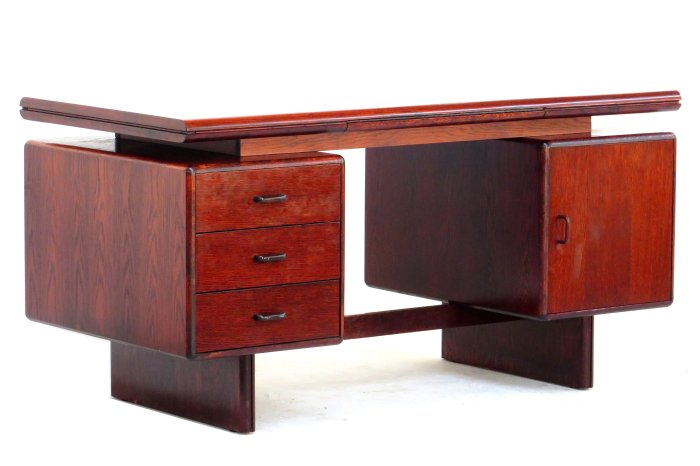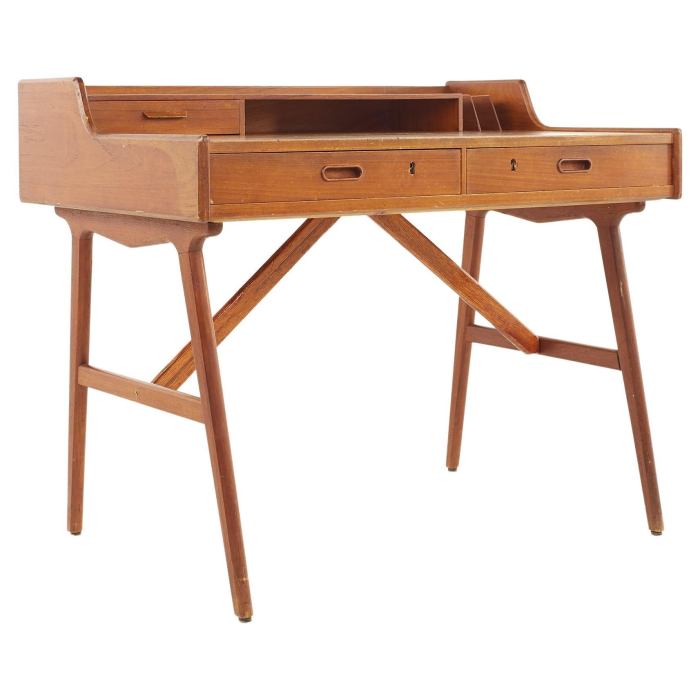Mid-century modern writing desk furniture represents a fascinating intersection of form and function. These desks, popularized in the mid-20th century, often feature clean lines, minimalist designs, and high-quality materials like teak and walnut. Their enduring appeal lies in their timeless elegance and adaptability to various interior styles, making them coveted pieces for both modern and vintage enthusiasts. The craftsmanship and attention to detail evident in these desks often elevate them beyond mere functional pieces to become statements of sophisticated taste.
From the iconic designs of Eero Saarinen to the more understated elegance of lesser-known makers, mid-century modern writing desks offer a diverse range of styles. Features like tapered legs, sleek drawer pulls, and integrated storage solutions contribute to their unique aesthetic. Many examples showcase a commitment to sustainability, using responsibly sourced woods and durable construction techniques that ensured longevity.
This focus on quality and enduring style is a key factor in their continued popularity today.
The mid-century modern aesthetic, flourishing roughly from the 1930s to the 1960s, continues to captivate design enthusiasts. Its clean lines, organic forms, and emphasis on functionality have transcended time, making mid-century modern furniture highly sought-after today. Among these iconic pieces, the writing desk holds a special place, representing a blend of practicality and style perfect for the home office or study.
This comprehensive guide delves into the world of mid-century modern writing desks, exploring their history, key characteristics, popular styles, materials, and how to incorporate them into contemporary spaces.

The History and Evolution of Mid-Century Modern Writing Desks
The mid-century modern movement emerged as a reaction against the ornate styles of the past. Designers sought to create furniture that was both functional and aesthetically pleasing, using innovative materials and techniques. Writing desks of this era reflect this philosophy, often featuring simple, uncluttered designs that prioritized ergonomics and efficient workspace organization. The post-war economic boom fueled mass production, making mid-century modern furniture, including writing desks, more accessible to a wider range of consumers.
Early mid-century modern desks often incorporated elements of Scandinavian design, emphasizing natural materials like wood and clean, minimalist lines. As the era progressed, designers experimented with new materials such as laminates and plastics, resulting in a wider variety of styles and finishes. The influence of designers like Eero Saarinen, Charles and Ray Eames, and Paul McCobb is clearly visible in many iconic mid-century modern writing desk designs.
Key Characteristics of Mid-Century Modern Writing Desks
- Clean Lines and Simple Forms: Avoidance of elaborate ornamentation, focusing instead on sleek silhouettes and geometric shapes.
- Tapered Legs: A hallmark feature, often seen in various styles, from splayed legs to elegantly tapered ones.
- Functional Design: Emphasis on practicality and efficient use of space, often incorporating features like built-in drawers, compartments, or pull-out shelves.
- Natural Materials: Extensive use of wood, particularly teak, walnut, and mahogany, often finished with a simple lacquer or stain.
- Organic Shapes: Incorporation of curved elements and organic forms, creating a sense of warmth and fluidity.
- Minimalist Aesthetics: A focus on simplicity and functionality, avoiding unnecessary embellishments.
Popular Styles and Materials
Mid-century modern writing desks encompass a range of styles, each with its unique characteristics. Some of the most popular styles include:
Scandinavian Modern Writing Desks
Characterized by their minimalist designs, use of light-colored wood (like birch or pine), and emphasis on functionality. Often feature simple, straight lines and lack excessive ornamentation. These desks often exude a sense of calm and serenity.
Danish Modern Writing Desks
Similar to Scandinavian Modern, but often incorporate more organic curves and slightly more decorative elements. The use of high-quality wood and meticulous craftsmanship is a defining feature.

American Modern Writing Desks, Mid-century modern writing desk furniture
This style encompasses a broader range of designs, often incorporating bolder colors and more playful shapes than their Scandinavian counterparts. Materials like laminate and molded plywood were frequently used.
Materials Used in Mid-Century Modern Writing Desks
- Wood: Teak, walnut, mahogany, birch, and pine were popular choices, prized for their durability and aesthetic appeal.
- Laminate: Offered a more affordable and versatile option, allowing for a wide range of colors and patterns.
- Metal: Used in legs or as accents, often in chrome or brass finishes, adding a touch of industrial chic.
- Plywood: A strong and lightweight material, often used in desk tops and drawers.
Incorporating Mid-Century Modern Writing Desks into Contemporary Spaces
The timeless appeal of mid-century modern writing desks makes them easy to integrate into various interior design styles. Their clean lines and neutral color palettes complement both traditional and contemporary settings. To enhance their impact, consider these tips:
- Pair with complementary furniture: Combine your mid-century modern desk with other pieces from the same era or with contemporary furniture that shares similar design principles.
- Choose the right lighting: A well-lit workspace is crucial. Consider a task lamp with a simple, elegant design to complement the desk.
- Accessorize thoughtfully: Keep the workspace organized and uncluttered. Use simple, functional accessories that enhance the mid-century modern aesthetic.
- Consider the color palette: Neutral colors like beige, gray, and brown work well with mid-century modern furniture. You can add pops of color through accessories.
Finding and Maintaining Your Mid-Century Modern Writing Desk
Finding an authentic mid-century modern writing desk can be a rewarding experience. Check online marketplaces like eBay and Etsy, antique shops, and vintage furniture stores. When purchasing, inspect the piece carefully for any signs of damage or wear and tear. Proper care and maintenance are essential to preserving the beauty and longevity of your desk. Regular dusting and polishing will help maintain its shine and protect the finish.
Frequently Asked Questions (FAQ)
- Q: How can I identify a genuine mid-century modern writing desk? A: Look for characteristic features such as clean lines, tapered legs, simple forms, and the use of materials like teak, walnut, or laminate. Research specific designers and manufacturers associated with the era.
- Q: What is the average price range for a mid-century modern writing desk? A: Prices vary widely depending on the designer, condition, and materials. Expect to pay anywhere from a few hundred dollars to several thousand dollars for a high-end piece.
- Q: How do I clean and maintain a mid-century modern writing desk? A: Regular dusting with a soft cloth is recommended. For more thorough cleaning, use a gentle wood cleaner and polish appropriate for the type of wood or finish.
- Q: Where can I find mid-century modern writing desks for sale? A: Online marketplaces (eBay, Etsy), antique shops, vintage furniture stores, and auction sites are good places to start your search.
- Q: Can I refinish a mid-century modern writing desk? A: Yes, but it’s important to research the proper techniques and materials to avoid damaging the piece. Consider consulting a professional if you’re unsure.
References: Mid-century Modern Writing Desk Furniture
- Pamono
-A curated selection of vintage and contemporary design. - 1stDibs
-A high-end marketplace for vintage and antique furniture. - Incollect
– A resource for finding antique and vintage furniture from reputable dealers.
Call to Action
Ready to add a touch of mid-century modern elegance to your home? Start browsing our curated selection of authentic and reproduction mid-century modern writing desks today! Find the perfect piece to inspire your creativity and elevate your workspace.
User Queries
What are the typical dimensions of a mid-century modern writing desk?
Dimensions vary greatly depending on the maker and model, but generally, they range from compact designs suitable for smaller spaces to larger desks with ample workspace.
How can I identify authentic mid-century modern writing desk furniture?
Look for hallmarks of the era, such as specific wood types (teak, walnut), distinctive leg styles (tapered, splayed), and minimalist hardware. Researching designers and manufacturers can also help authenticate a piece.
How much does a mid-century modern writing desk typically cost?
Prices vary widely depending on the maker, condition, and rarity of the piece. Expect a significant range, from several hundred dollars for more common pieces to thousands for rare or highly sought-after designs.
